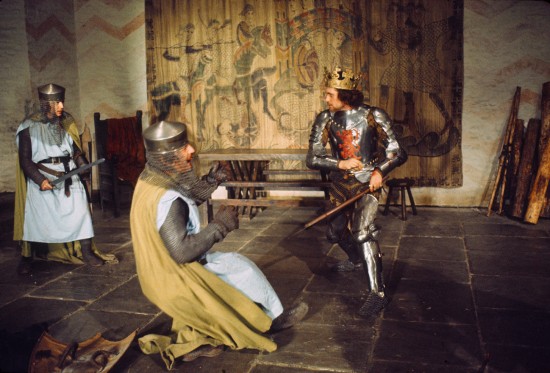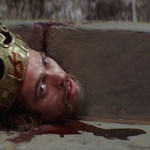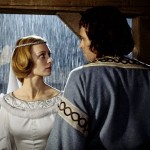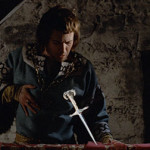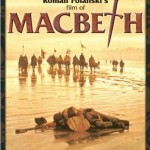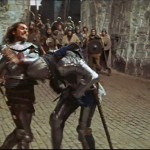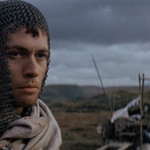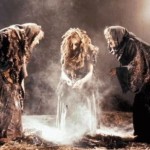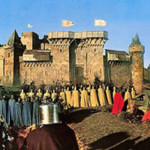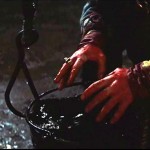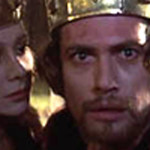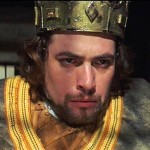Given that a new film version of “the Scottish play” is now doing the rounds it seemed a good excuse for watching and reviewing the 1971 Polanski movie, filmed not long after the gruesome murder of his pregnant wife Sharon Tate and several of their friends by the Manson gang.
Roman Polanski has in any case a reputation for taking viewers out of their comfort zone so it is unsurprising that this translation should be widely regarded as a horror movie above all else. Given sponsorship by the Playboy organisation you might also expect some degree of titillation (remember Caligula, sponsored by Bob Guccione who insisted on the inclusion of soft porn, to the detriment of the movie and the disgust of the many distinguished actors casted?)
In fact, this Macbeth is neither of those things; nor is it, as the critics of the time would have it, reducing Shakespeare to the realms of flashy melodrama. From Wikipedia:
Upon release in October 1971, Macbeth received mixed reviews. Some critics found the film’s graphic violence and nudity distracting, complaining that such blatancy and literalness diminished the complexity and ambiguity of the original text. Moreover, the single-minded bleakness and unrelenting brutality of Polanski’s vision was faulted by less sympathetic commentators as being a crude and monotonous oversimplification of the play which, in Pauline Kael‘s view, ultimately “reduces Shakespeare’s meanings to the banal theme of ‘life is a jungle'”.
Other critics, however, praised the film for its technical excellence, vivid atmosphere, fluid cinematic narrative and compelling modern interpretation of Shakespeare’s tragedy. Roger Ebert (film critic of the Chicago Sun-Times) gave it 4 out of 4 stars saying that “It’s an original film by an original film artist, and not an interpretation”. The U.S. National Board of Review named Macbeth the Best Film of 1971.
Granted Polanski polarises his audiences, critics included, but few are better at getting to the nub. This screenplay was adapted by the director and the late great drama critic Kenneth Tynan (also famed for the revue Oh! Calcutta!, which at the time was deemed a daring challenge to contemporary sexual mores.)
It adds no text but takes away much, focusing instead on a starkly visual and cinematic experience, getting down to the visceral nitty gritty – perhaps no less than you would expect of the made who made, for example, Repulsion and many more movies in which the image is ultimately more haunting than the poetic language. In the process, it’s not difficult to see how the nuances and subtleties of the text might be lost, though whether that translation contrives to being “dumbing down” is an interesting question.
Perhaps a better question might be who Polanski was aiming the movie at – the answer being the modern mainstream audience who tend to follow the cinematic virtues of using one stark image in preference to a thousand words. Not that the language does not have its place, but Polanski uses the tools of his trade to go where stage cannot.
For example, as Macbeth prepares to kill Duncan, he says famously, “is this a dagger I see before me?” Here, the dagger is virtual – it hangs in the air to point the murderer in the direction of his victim, whence to commit the act of regicide en route to being proclaimed monarch in succession. Another example, courtesy of Wikipedia:
When Macbeth confronts the Witches a second time and is invited to gaze into their cauldron to glimpse his future, the scene becomes a cryptic, hallucinatory set piece in which Polanski makes a rare use of cascading montage imagery. Macbeth is warned by his Doppelgänger of the dangers to hand, culminating in a surreal visual allegory of the eventual, dynastic triumph of Banquo’s heirs as each king is seen holding up a looking glass which contains the image of his successor. This mise en abyme effect is repeated eightfold until, ultimately, young Fleance is seen grinning and crowned in the final, eighth looking glass—an allusion to Shakespeare’s original stage direction that the last Banquo appear holding a looking glass, as well as the historical myth that King James I of England was descended from Banquo by eight generations.
Is the use of blood and gore sensationalist? Well it would undoubtedly attract a few horror fans en route, but I don’t believe the movie to be any more blood curdling than the text on which it is based – and considerably less so than Titus Andronicus, a play certainly not for the squeamish (see here for a trailer of the recent RSC production.) The various murders are portrayed vividly but it may be the off-screen significance that concerned the critics. This also from Wikipedia:
Many were particularly disturbed by the lurid manner in which Polanski depicted the bloody slaughter of Macduff’s wife and children. Kael went so far as to say that Polanski seemed to stage the scene as a deliberate evocation of the Manson Murders.
The beheading scene did not seem any more lurid than necessary, but given the medium you could not portray the film without it – which makes me all the more intrigued to know how the current version depicts the key events (trailer here.) First thing to notice is that the witches are now comparatively normal, where Polanski has them both naked and disturbingly ugly – which to me seems apt and closer to the original Shakespearean vision.
Jon Finch, an actor who could easily have achieved so much more in his career, portrays a brooding, uncertain Macbeth – all the more introspective for the internalised soliloquies:
The soliloquies are presented naturalistically as voiceover narration and without the unambiguous emotional subtext of a conventional musical score. Instead, the actors’ voices are heard sotto voce accompanied by the atonal wails and drones of the Third Ear Band. As in his earlier Repulsion (1965), Polanski employs ominously unnatural silences and amplified sounds to create a sense of enveloping discomfort and dread.
I like Finch for his shades of mood and introspective evaluation, brought through during the soliloquies. His words might be voiced over but his face conveys deeper meaning, but as you would hope. It would be interesting to see how he addressed the role on stage, though sadly we will never have the opportunity,
His confrontation with Banquo’s bloodied ghost is what invokes his madness, maybe one similarity with Hamlet, though here the death was at the direct order of the leading protagonist. Certainly this spirit awakens much fear and paranoia.
Lady Macbeth is the villain of the piece, egging on her husband to commit the foul and bloody deed – though as played by Francesca Annis she appears almost bewildered and incapable of comprehending the horror of what she has done.
Her infamous sleepwalking scene, whereby she attempts to wash out the mythical blood spot from her hands, is conducted by in the nude – though not pruriently so. In fact, it is entirely appropriate, given that the character is, through sleep, metaphorically more vulnerable than at any other time.
So then – a fairly traditional Macbeth but stripped of its words but with greater propensity to metaphor and graphic image. Watch this space for a review of the new movie!

